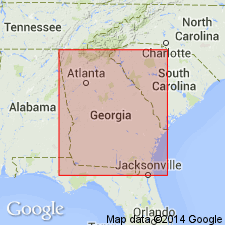
- Usage in publication:
-
- Red Mountain group, formation
- Modifications:
-
- Named
- Dominant lithology:
-
- Sandstone
- Shale
- AAPG geologic province:
-
- Appalachian basin
Summary:
Clinton is the only one of the three Niagaran groups that has been identified in AL. In TN, the group has been called Dyestone group by Prof. Safford for the occurrence of red ore, or dyestone, within it. In AL, according to the author, the best name is Red Mountain group for outcrops of the rocks are found in ridges, or mountains, extending almost continuously from Bigg Co. to GA and beyond. Locally, these ridges are called Red Mountain because of the red ore, which is always present in some degree. The name Clinton, however, has already been applied to this group of rocks, and "a multiplication of names for the same thing is to be avoided if possible." The rocks of the Clinton group in AL are chiefly green, yellowish, brown, and red thin sandstones and shales. The group contains several beds of lenticular or fossiliferous red iron ore. Characteristic sections of strata of Clinton group occur near Tannehill and at mines in Eureka Co. A conglomerate along the base of the mountain near Columbiana probably underlies the Red Mountain rocks and belongs to Medina group. [According to C. Butts, 1926 (AL G.S. Spec. Rept. no. 14) the Red Mountain formation is absent in Montevallo and Columbiana quads, and the conglomerate referred to here is of Devonian age.]
Source: GNU records (USGS DDS-6; Reston GNULEX).

- Usage in publication:
-
- Red Mountain Formation
- Modifications:
-
- Areal extent
- AAPG geologic province:
-
- Appalachian basin
Summary:
Only the lower member of the Red Mountain Formation is exposed in the first cut at Ringgold Gap, GA, where it is 82 m thick. At the base, silty shales are interbedded with thin bioturbated fine grained sandstones. Percentage and thickness of sandstone increases upwards with graded beds showing plain and ripple lamination. Sole marks are abundant and include burrows, tool marks, gutter casts, rare flutes, and load structures. Above these graded beds are hummocky-cross-bedded sandstones interbedded with fissile shales. At the top of the section, are medium to coarse grained cross-bedded sandstones, ripple laminated sandstones and shales, indicative of upper shoreface deposition. Deposits are increasingly hematitic and are capped with a seam of ironstone. The middle and upper members of the Red Mountain Formation consist of graded and hummocky cross-bedded sandstones with shales much like those in the lower portion of the formation. They form two more incomplete coarsening-upward sequences--without upper shoreface facies and ironstones. Red Mountain Formation overlies Mannie Shale Member of Sequatchie Formation.
Source: GNU records (USGS DDS-6; Reston GNULEX).
For more information, please contact Nancy Stamm, Geologic Names Committee Secretary.
Asterisk (*) indicates published by U.S. Geological Survey authors.
"No current usage" (†) implies that a name has been abandoned or has fallen into disuse. Former usage and, if known, replacement name given in parentheses ( ).
Slash (/) indicates name conflicts with nomenclatural guidelines (CSN, 1933; ACSN, 1961, 1970; NACSN, 1983, 2005, 2021). May be explained within brackets ([ ]).

